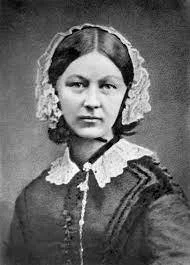MOTW - Florence Nightingale
Mathematician of the week is Florence Nightingale, born May 12th, 1820.
Florence Nightingale is best remembered for her work as a nurse during the Crimean War and her contribution towards the reform of the sanitary conditions in military field hospitals. However, what is less well known about this amazing woman is her love of mathematics, especially statistics, and how this love played an important part in her life's work.
Some excerpts from her bio, which I encourage you to fully read...link at the bottom
In 1840, Nightingale begged her parents to let her study mathematics,
but her mother did not approve of this idea. Although William Nightingale loved mathematics and had bequeathed this love to his daughter, he urged her to study subjects more appropriate for a woman. After many long emotional battles, Nightingale's parents finally gave their permission and allowed her to be tutored in mathematics. Her tutors included Sylvester, who developed the theory of invariants with Cayley. Nightingale was said to be Sylvester's most distinguished pupil. Lessons included learning arithmetic, geometry and algebra and prior to Nightingale entered nursing, she spent time tutoring children in these subjects.
March of 1854 brought the start of the Crimean War, with Britain, France and Turkey declaring war on Russia. Although the Russians were defeated at the battle of the Alma River, on 20 September 1854, The Times newspaper criticised the British medical facilities. In response to this Nightingale was asked in a letter from her friend Sidney Herbert, the British Secretary for War, to become a nursing administrator to oversee the introduction of nurses to military hospitals. Her official title was Superintendent of the Female Nursing Establishment of the English General Hospitals in Turkey. Nightingale arrived in Scutari, an Asian suburb of Constantinople, (now Istanbul), with 38 nurses on 4 November 1854 [2]:-
... her zeal, her devotion, and her perseverance would yield to no rebuff and to no difficulty. She went steadily and unwearyingly about her work with a judgement, a self-sacrifice, a courage, a tender sympathy, and withal a quiet and unostentatious demeanour that won the hearts of all who were not prevented by official prejudices from appreciating the nobility of her work and character.
Although being female meant Nightingale had to fight against the military authorities at every step, she went about reforming the hospital system. With conditions which resulted in soldiers lying on bare floors surrounded by vermin and unhygienic operations taking place it is not surprising that, when Nightingale first arrived in Scutari, diseases such as cholera and typhus were rife in the hospitals. This meant that injured soldiers were 7 times more likely to die from disease in hospital, than on the battlefield. Whilst in Turkey, Nightingale collected data and organised a record keeping system, this information was then used as a tool to improve city and military hospitals. Nightingale's knowledge of mathematics became evident when she used her collected data to calculate the mortality rate in the hospital. These calculations showed that an improvement of the sanitary methods employed would result in a decrease in the number of deaths. By February 1855 the mortality rate had dropped from 60% to 42.7%. Through the establishment of a fresh water supply as well as using her own funds to buy fruit, vegetables and standard hospital equipment, the mortality rate in the spring had dropped further to 2.2%.
piechart
Nightingale used this statistical data to create her Polar Area Diagram, or "coxcombs" as she called them. These were used to give a graphical representation of the mortality figures during the Crimean War (1854 - 56).
The area of each coloured wedge, measured from the centre as a common point, is in proportion to the statistic it represents. The blue outer wedges represent the deaths from preventable or mitigable zymotic diseases, or in other words contagious diseases such as cholera and typhus. The central red wedges show the deaths from wounds. The black wedges in between represent deaths from all other causes. Deaths in the British field hospitals reached a peak during January 1855, when 2,761 soldiers died of contagious diseases, 83 from wounds and 324 from other causes making a total of 3,168. The army's average manpower for that month was 32,393. Using this information, Nightingale computed a mortality rate of 1,174 per 10,000 with 1,023 per 10,000 being from zymotic diseases. If this rate had continued, and troops had not been replaced frequently, then disease alone would have killed the entire British army in the Crimea.
Alink to her full bio: https://mathshistory.st-andrews.ac.uk/Biogra.../Nightingale/

